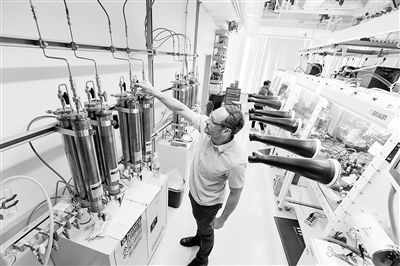Contact Us
New materials are made like plastic but conduct like metal

Scientists have discovered a way to make a material that can be made like plastic but conducts more like metal. The picture shows members of Anderson's laboratory working.
Source: University of Chicago
Scientists at the University of Chicago have found a way to create a material that is made like plastic but conducts more like metal. The study, published in the journal Nature on the 26th, shows how to create a material that is cluttered with molecular fragments but still conducts electricity extremely well. This breakthrough points to an entirely new design principle for electronics that could open the way to the invention of new types of materials.
This research runs counter to the rules of conductivity, and for scientists, it is like seeing a car on the water, but still driving at a speed of about 100 kilometers per hour. The senior author of the study, John Anderson, an associate professor of chemistry at the University of Chicago, said, "In principle, this opens up the design of a completely new material that is conductive, easy to form, and very strong in everyday conditions."
Conductive materials are an absolute necessity in the manufacture of any type of electronic device, whether it is a smartphone, a solar panel or a television. By far, the oldest and largest group of conductors are metals: copper, gold, and aluminum. About 50 years ago, scientists were able to create conductors made of organic materials using a chemical process called "doping. "Doping" refers to the scattering of different atoms or electrons into materials. These materials are more flexible and easier to process than traditional metals, but the problem is that they are less stable. If exposed to moisture or temperature is too high, they may lose conductivity.
Scientists believe that a material must have a straight, orderly arrangement of internal molecules to conduct electricity effectively. So the researchers tested nickel atoms like pearls in a string of molecular beads made of carbon and sulfur.
To the scientists' surprise, the material conducts electricity easily and is highly conductive. More importantly, it is very stable. This new material can be manufactured at room temperature and is not affected by heat, cold, humidity, and acid-base environments.
Even more surprising is that the molecular structure of this material is disordered. "From a fundamental point of view, this should not be a metal." Anderson said, "There is no one reliable theory to explain this."
Scientists are trying to understand how this material conducts electricity. After testing, simulation and theoretical work, they believe that this material can form layers, like flakes in a lasagna. Even if the sheets rotate laterally and no longer form a neat lasagna stack, the electrons can still move horizontally or vertically as long as the sheets touch each other.
Anderson said: "It's almost like conductive plasticine. Apply it in place and it will conduct electricity". (Intern reporter Zhang Jiaxin)
(Editor: Zhao Zhuqing, Chen Jian)




